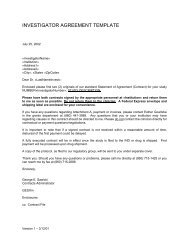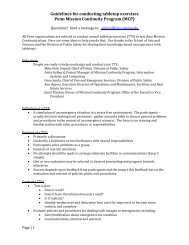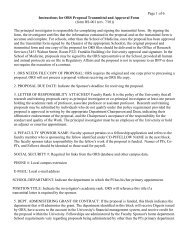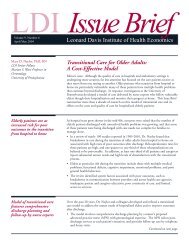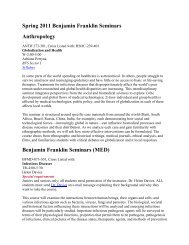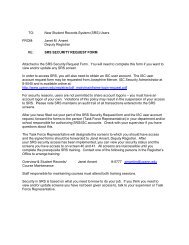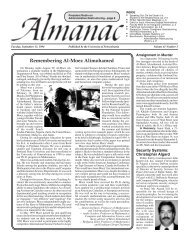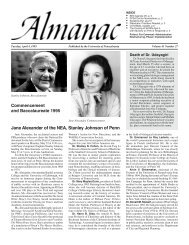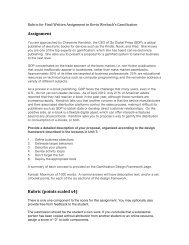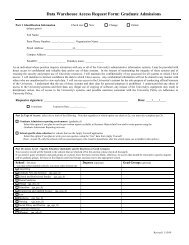Patient-Centered Communication Ratings of Care and Concord.pdf
Patient-Centered Communication Ratings of Care and Concord.pdf
Patient-Centered Communication Ratings of Care and Concord.pdf
Create successful ePaper yourself
Turn your PDF publications into a flip-book with our unique Google optimized e-Paper software.
<strong>Patient</strong>-<strong>Centered</strong> <strong>Communication</strong>, <strong>Ratings</strong> <strong>of</strong> <strong>Care</strong>, <strong>and</strong> <strong>Concord</strong>ance<br />
<strong>of</strong> <strong>Patient</strong> <strong>and</strong> Physician Race<br />
Lisa A. Cooper, MD, MPH; Debra L. Roter, DrPH; Rachel L. Johnson, BA; Daniel E. Ford, MD, MPH; Donald M. Steinwachs, PhD;<br />
<strong>and</strong> Neil R. Powe, MD, MPH, MBA<br />
Article<br />
Background: African-American patients who visit physicians <strong>of</strong><br />
the same race rate their medical visits as more satisfying <strong>and</strong><br />
participatory than do those who see physicians <strong>of</strong> other races.<br />
Little research has investigated the communication process in<br />
race-concordant <strong>and</strong> race-discordant medical visits.<br />
Objectives: To compare patient–physician communication in<br />
race-concordant <strong>and</strong> race-discordant visits <strong>and</strong> examine whether<br />
communication behaviors explain differences in patient ratings <strong>of</strong><br />
satisfaction <strong>and</strong> participatory decision making.<br />
Design: Cohort study with follow-up using previsit <strong>and</strong> postvisit<br />
surveys <strong>and</strong> audiotape analysis.<br />
Setting: 16 urban primary care practices.<br />
<strong>Patient</strong>s: 252 adults (142 African-American patients <strong>and</strong> 110<br />
white patients) receiving care from 31 physicians (<strong>of</strong> whom 18<br />
were African-American <strong>and</strong> 13 were white).<br />
Measurements: Audiotape measures <strong>of</strong> patient-centeredness,<br />
patient ratings <strong>of</strong> physicians’ participatory decision-making styles,<br />
<strong>and</strong> overall satisfaction.<br />
Results: Race-concordant visits were longer (2.15 minutes [95%<br />
CI, 0.60 to 3.71]) <strong>and</strong> had higher ratings <strong>of</strong> patient positive affect<br />
(0.55 point, [95% CI, 0.04 to 1.05]) compared with race-discordant<br />
visits. <strong>Patient</strong>s in race-concordant visits were more satisfied<br />
<strong>and</strong> rated their physicians as more participatory (8.42 points [95%<br />
CI, 3.23 to 13.60]). Audiotape measures <strong>of</strong> patient-centered communication<br />
behaviors did not explain differences in participatory<br />
decision making or satisfaction between race-concordant <strong>and</strong> racediscordant<br />
visits.<br />
Conclusions: Race-concordant visits are longer <strong>and</strong> characterized<br />
by more patient positive affect. Previous studies link similar<br />
communication findings to continuity <strong>of</strong> care. The association<br />
between race concordance <strong>and</strong> higher patient ratings <strong>of</strong> care is<br />
independent <strong>of</strong> patient-centered communication, suggesting that<br />
other factors, such as patient <strong>and</strong> physician attitudes, may mediate<br />
the relationship. Until more evidence is available regarding the<br />
mechanisms <strong>of</strong> this relationship <strong>and</strong> the effectiveness <strong>of</strong> intercultural<br />
communication skills programs, increasing ethnic diversity<br />
among physicians may be the most direct strategy to improve<br />
health care experiences for members <strong>of</strong> ethnic minority groups.<br />
Ann Intern Med. 2003;139:907-915.<br />
For author affiliations, see end <strong>of</strong> text.<br />
See editorial comment on pp 952-953.<br />
www.annals.org<br />
Compelling evidence demonstrates racial, ethnic, <strong>and</strong><br />
social disparities in health care in the United States<br />
(1–11). African Americans <strong>and</strong> other ethnic minority patients<br />
in race-discordant relationships with their physicians<br />
(for example, an African-American patient who visits a<br />
white physician) report less involvement in medical decisions,<br />
less partnership with physicians, lower levels <strong>of</strong> trust<br />
in physicians, <strong>and</strong> lower levels <strong>of</strong> satisfaction with care<br />
(12–15). A recent report from the Institute <strong>of</strong> Medicine on<br />
racial <strong>and</strong> ethnic disparities in health care suggests that<br />
various aspects <strong>of</strong> the patient–physician relationship may<br />
contribute to the wide disparities seen in U.S. health care<br />
(16). Despite emerging evidence linking interpersonal aspects<br />
<strong>of</strong> care, such as patient–physician communication, to<br />
continuity <strong>of</strong> care <strong>and</strong> health outcomes (17–22), most<br />
studies <strong>of</strong> disparity have focused on technical aspects <strong>of</strong><br />
health care, such as receipt <strong>of</strong> certain tests, procedures, <strong>and</strong><br />
therapies.<br />
Interpersonal communication is sensitive to race concordance.<br />
For instance, The Commonwealth Fund’s 2001<br />
Health <strong>Care</strong> Quality Survey found substantially higher<br />
rates <strong>of</strong> reported difficulties in communication for African-<br />
American, Hispanic, <strong>and</strong> Asian patients than for white patients<br />
(23). Especially disturbing were the findings that<br />
15% <strong>of</strong> African Americans believed that they would receive<br />
better care if they were <strong>of</strong> a different race or ethnicity <strong>and</strong><br />
that African Americans were almost twice as likely as their<br />
white counterparts (16% versus 9%) to report being<br />
treated with disrespect during a recent health care visit.<br />
Few studies have directly observed medical communication<br />
to determine possible interpersonal pathways<br />
through which race concordance between patient <strong>and</strong> physician<br />
affect patient ratings <strong>of</strong> care. We investigated how<br />
race concordance affects patient–physician communication<br />
<strong>and</strong> patient ratings <strong>of</strong> physicians’ participatory decisionmaking<br />
style <strong>and</strong> visit satisfaction. We hypothesized that<br />
race concordance is associated with higher levels <strong>of</strong> communication<br />
behaviors that are considered patient centered,<br />
higher patient ratings <strong>of</strong> physicians’ participatory decision<br />
making, <strong>and</strong> higher ratings <strong>of</strong> patient satisfaction. Furthermore,<br />
we hypothesized that elements <strong>of</strong> patient–physician<br />
communication would moderate the relationship between<br />
race concordance <strong>and</strong> patient ratings <strong>of</strong> care.<br />
METHODS<br />
Study Design <strong>and</strong> Sample<br />
We conducted a cohort study with follow-up <strong>of</strong> patients<br />
seeing primary care physicians in 16 urban primary<br />
care practices. Physicians were recruited from the rosters <strong>of</strong><br />
group practices serving managed care <strong>and</strong> fee-for-service<br />
patients in the Baltimore <strong>and</strong> Washington, D.C., metro-<br />
© 2003 American College <strong>of</strong> Physicians 907
Article <strong>Patient</strong>-<strong>Centered</strong> <strong>Communication</strong> in Primary <strong>Care</strong> Visits<br />
Context<br />
<strong>Concord</strong>ant physician–patient ethnicity is associated with<br />
favorable patient ratings <strong>of</strong> care. Whether communication<br />
differs when physician <strong>and</strong> patient share ethnic background<br />
is unknown.<br />
Contribution<br />
The authors audiotaped 252 primary care visits. When<br />
both physician <strong>and</strong> patient were African American or both<br />
were white, the visit was about 2 minutes longer <strong>and</strong> the<br />
patient’s affect was more positive than when ethnicity differed.<br />
However, concordant ethnicity was not associated<br />
with communication patterns that the researchers defined<br />
as more patient centered than physician centered.<br />
Implications<br />
<strong>Patient</strong>-centered communication does not appear to explain<br />
the favorable ratings <strong>of</strong> care, longer visits, <strong>and</strong> positive<br />
patient affect that occur when patients see physicians<br />
whose ethnic background is similar to their own.<br />
–The Editors<br />
politan area. We specifically targeted practices with a high<br />
percentage <strong>of</strong> African-American physicians <strong>and</strong> patients.<br />
Three <strong>of</strong> the practices were federally qualified community<br />
health centers. After meetings with practice leaders, the<br />
principal investigator invited physicians who delivered primary<br />
care to patients at least 30 hours per week <strong>and</strong> who<br />
self-reported their race to be African-American or white to<br />
participate by letter <strong>and</strong> follow-up telephone calls. Hispanic<br />
<strong>and</strong> Asian physicians <strong>and</strong> physicians who were in<br />
clinical training were excluded.<br />
Between July 1998 <strong>and</strong> July 1999, a research assistant<br />
recruited patients consecutively from waiting rooms <strong>of</strong><br />
physicians’ <strong>of</strong>fices over 1 to 2 days per physician. The target<br />
sample was 10 patients per physician. <strong>Patient</strong>s who<br />
were 18 years <strong>of</strong> age or older, were seeing their physician<br />
on recruitment days, <strong>and</strong> self-defined their race as white or<br />
African-American were eligible for the study. Efforts were<br />
made to recruit patients who had an established relationship<br />
with their physician. The research assistant did not<br />
approach patients who appeared too acutely ill or cognitively<br />
impaired to participate in the interview.<br />
Data Collection<br />
The study procedures were reviewed <strong>and</strong> approved by<br />
the Johns Hopkins Medical Institutions Institutional Review<br />
Board. All participating patients <strong>and</strong> physicians gave<br />
informed consent. They were told that the goal <strong>of</strong> the<br />
study was to learn about how physicians <strong>and</strong> patients communicate<br />
with each other. At the start <strong>of</strong> each visit, research<br />
assistants set up a tape recorder in the physician’s<br />
<strong>of</strong>fice, started the tape, <strong>and</strong> left the <strong>of</strong>fice. Physicians <strong>and</strong><br />
patients were free to turn the tape <strong>of</strong>f at any time during<br />
the encounter.<br />
Before the medical visit, patients completed a<br />
5-minute survey about their health status, as measured<br />
with one item from the Medical Outcomes Study Short<br />
Form (“In general, how would you rate your health?”[24])<br />
<strong>and</strong> demographic characteristics (age, gender, race, <strong>and</strong> educational<br />
status). After the medical visit, they completed a<br />
survey that included a 3-item rating <strong>of</strong> the physician’s participatory<br />
decision-making style (12) <strong>and</strong> questions about<br />
overall satisfaction with the visit <strong>and</strong> whether the patient<br />
would recommend the physician to a friend. Physicians<br />
completed a background survey that included questions<br />
about demographic characteristics (age, gender, race, specialty,<br />
<strong>and</strong> number <strong>of</strong> years in practice) <strong>and</strong> a postvisit<br />
survey that included a question about how well they knew<br />
each patient.<br />
Study Variables<br />
The main independent variable for our analyses was<br />
race concordance between African-American <strong>and</strong> white patients<br />
<strong>and</strong> physicians. The main dependent variables were<br />
derived from two sources: audiotaped recordings <strong>of</strong> medical<br />
visits <strong>and</strong> postvisit patient ratings <strong>of</strong> the physician’s<br />
participatory decision-making style <strong>and</strong> patient satisfaction.<br />
Audiotape Analysis<br />
Audiotapes were analyzed by using the Roter Interaction<br />
Analysis System, a widely used coding system with<br />
demonstrated reliability <strong>and</strong> predictive validity in studies<br />
<strong>of</strong> patient–physician communication (25–27). This system<br />
assigns each complete thought expressed by the patient <strong>and</strong><br />
physician to 1 <strong>of</strong> 37 mutually exclusive <strong>and</strong> exhaustive<br />
codes or categories <strong>of</strong> communication. These categories<br />
can be manipulated to reflect groups <strong>of</strong> exchange representing<br />
3 recognized functions <strong>of</strong> the medical interview:<br />
data gathering (open <strong>and</strong> closed biomedical <strong>and</strong> psychosocial<br />
questions), patient education <strong>and</strong> counseling about<br />
biomedical <strong>and</strong> psychosocial topics, <strong>and</strong> relationship building<br />
through emotionally responsive exchange (empathy,<br />
concern, approval, <strong>and</strong> reassurance) (28). A fourth function<br />
<strong>of</strong> partnership building (seeking patient opinion, asking<br />
for underst<strong>and</strong>ing, <strong>and</strong> checking for underst<strong>and</strong>ing<br />
through paraphrase <strong>and</strong> interpretation) is also reflected (29).<br />
The Figure shows communication elements <strong>and</strong> ratings<br />
<strong>of</strong> care by patients. The following communication<br />
elements were derived for the audiotape analysis: 1) duration<br />
<strong>of</strong> the visit, measured in minutes; 2) speech speed<br />
(total number <strong>of</strong> statements made by patients <strong>and</strong> physicians<br />
per minute); 3) physician verbal dominance (the<br />
number <strong>of</strong> physician statements divided by the number <strong>of</strong><br />
patient statements); <strong>and</strong> 4) patient-centered interviewing,<br />
which is a ratio <strong>of</strong> all codes relating to socioemotional <strong>and</strong><br />
psychosocial elements <strong>of</strong> exchange (all partnership-building;<br />
psychosocial information <strong>and</strong> counseling; relationshipbuilding;<br />
positive, negative, <strong>and</strong> social talk by physicians<br />
<strong>and</strong> patients; all physician open-ended questions; <strong>and</strong> all<br />
908 2 December 2003 Annals <strong>of</strong> Internal Medicine Volume 139 • Number 11 www.annals.org
<strong>Patient</strong>-<strong>Centered</strong> <strong>Communication</strong> in Primary <strong>Care</strong> Visits<br />
Article<br />
Figure. Relations <strong>of</strong> patient–physician race concordance with patient-centered communication <strong>and</strong> patient ratings <strong>of</strong> care.<br />
patient questions) divided by codes that further the biomedical<br />
agenda (the sum <strong>of</strong> all physician <strong>and</strong> patient biomedical<br />
information <strong>and</strong> counseling, orientations, <strong>and</strong><br />
physician closed-ended questions) (27, 30). A value greater<br />
than 1 indicates a more patient-centered encounter, <strong>and</strong> a<br />
value less than 1 indicates a more physician-centered encounter.<br />
In addition to categorization <strong>of</strong> verbal communication,<br />
Roter Interaction Analysis System coders were asked<br />
to rate the global affect (emotional context) <strong>of</strong> the dialogue<br />
on each audiotape across several dimensions on a numeric<br />
scale <strong>of</strong> 1 to 6, on which 1 represented low or none <strong>and</strong> 6<br />
was high. <strong>Patient</strong> positive affect is a composite variable<br />
developed by using factor analysis <strong>and</strong> is the sum <strong>of</strong> ratings<br />
<strong>of</strong> engagement, interest, friendliness, <strong>and</strong> responsiveness.<br />
Similarly, physician positive affect is a composite variable<br />
developed by using factor analysis <strong>and</strong> is the sum <strong>of</strong> ratings<br />
<strong>of</strong> interest, friendliness, responsiveness, sympathy, <strong>and</strong> hurried/rushed.<br />
“Hurried/rushed” is reverse coded (that is, a<br />
higher score represents a more negative state) because <strong>of</strong> its<br />
negative relationship with the other dimensions. A detailed<br />
description <strong>of</strong> the factor analysis appears in the Appendix,<br />
available at www.annals.org. Interitem reliability (Cronbach<br />
) was 0.82 for patient positive affect <strong>and</strong> 0.88 for<br />
physician positive affect.<br />
Two coders who were experienced in using the Roter<br />
Interaction Analysis System performed all coding. The<br />
coders were white women who were blinded to the study<br />
hypotheses. They were not given the race <strong>of</strong> the patients or<br />
physicians, but they may not have been blinded to this<br />
information. Reliability was assessed by a 10% r<strong>and</strong>om<br />
sample <strong>of</strong> double-coded tapes (n 27) drawn throughout<br />
the coding period. Intercoder reliability averaged 0.90 over<br />
the physician categories (range, 0.52 to 1.00) <strong>and</strong> 0.86<br />
over the patient categories (range, 0.45 to 1.00). All reliability<br />
coefficients less than 0.70 are in communication<br />
categories with low frequency (1 statement per visit).<br />
Coder agreement within 1 point on the patient <strong>and</strong> physician<br />
positive affect scales ranged from 88% to 100%.<br />
<strong>Patient</strong> <strong>Ratings</strong> <strong>of</strong> <strong>Care</strong> as Measured by Post-Visit Survey<br />
The participatory decision-making style <strong>of</strong> physicians<br />
is defined as the propensity <strong>of</strong> physicians to involve patients<br />
in treatment decisions. It was measured by patient<br />
report as the aggregate <strong>of</strong> 3 items, each rated on a 5-point<br />
scale from 0 (never) to 4 (very <strong>of</strong>ten): 1) If there were a<br />
choice between treatments, how <strong>of</strong>ten would this doctor<br />
ask you to help make the decision? 2) How <strong>of</strong>ten does this<br />
doctor give you some control over your treatment? <strong>and</strong> 3)<br />
How <strong>of</strong>ten does this doctor ask you to take some <strong>of</strong> the<br />
responsibility for your treatment? The highest possible score is<br />
12. By convention, the raw score is divided by 12 <strong>and</strong><br />
multiplied by 100 to arrive at a point scale <strong>of</strong> 0 to 100. A<br />
higher score means that the visit was more participatory (12).<br />
<strong>Patient</strong> satisfaction was measured by using 2 statements<br />
for which patients were asked to indicate their level<br />
<strong>of</strong> agreement or disagreement rated on a 5-point Likert<br />
scale from 1 (strongly disagree) to 5 (strongly agree):<br />
“Overall, I was satisfied with this visit” <strong>and</strong> “I would recommend<br />
this physician to a friend.” On the basis <strong>of</strong> the<br />
distribution <strong>of</strong> responses, we grouped patients into 1 <strong>of</strong> 2<br />
categories (1 “strongly agree” or 0 “less than strongly<br />
agree”) for each statement <strong>and</strong> analyzed them as dichotomous<br />
variables.<br />
Statistical Analysis<br />
Linear <strong>and</strong> logistic regression with generalized estimating<br />
equations were used to assess the presence, strength,<br />
<strong>and</strong> statistical associations between race concordance <strong>and</strong><br />
our dependent variables. The generalized estimating equations<br />
method was preferred over traditional regression because<br />
it accounts for the clustering effects <strong>of</strong> any withinphysician<br />
correlation <strong>and</strong> the different number <strong>of</strong> patients<br />
per physician (31, 32). We assumed an exchangeable correlation<br />
structure because it provides valid <strong>and</strong> robust estimates<br />
even if the correct correlation structure is misspecified.<br />
Because odds ratios tend to overstate the probability<br />
<strong>of</strong> frequent events, we present estimated probabilities for<br />
logistic regression analyses instead <strong>of</strong> odds ratios. Adjusted<br />
probabilities compare patients in race-concordant versus<br />
www.annals.org 2 December 2003 Annals <strong>of</strong> Internal Medicine Volume 139 • Number 11 909
Article <strong>Patient</strong>-<strong>Centered</strong> <strong>Communication</strong> in Primary <strong>Care</strong> Visits<br />
race-discordant dyads while holding all covariates in a<br />
given model constant at the mean value (for continuous<br />
variables) or the average probability <strong>of</strong> belonging in a particular<br />
category (for dichotomous variables) <strong>and</strong> thus allow<br />
comparisons between two otherwise equivalent patients, on<br />
the basis <strong>of</strong> the available data.<br />
Some physicians practiced at more than 1 site, <strong>and</strong><br />
there were 16 sites with an average <strong>of</strong> only 2 physicians per<br />
site. We therefore accounted for intraclass correlation<br />
within physicians rather than within sites. Covariates were<br />
identified for the analysis on the basis <strong>of</strong> theoretical considerations<br />
(patient gender) <strong>and</strong> if they were associated<br />
with race concordance <strong>and</strong> at least 2 <strong>of</strong> the patient-centered<br />
communication indicators at a P value less than 0.10.<br />
Multivariate analyses adjusted for patient factors (age, race,<br />
gender, <strong>and</strong> health status) <strong>and</strong> physician factors (gender<br />
<strong>and</strong> years since completion <strong>of</strong> training). Because the evidence<br />
that gender concordance in the patient–physician<br />
relationship matters is inconclusive (13, 33–36) <strong>and</strong> our<br />
analyses showed that gender concordance was not related<br />
to race concordance or any <strong>of</strong> our indicators, it was not<br />
included in our models. In addition, our measure <strong>of</strong> how<br />
well the physician knew the patient was related to only one<br />
patient-centered communication indicator <strong>and</strong> not to race<br />
concordance; we therefore excluded it from our models.<br />
In separate analyses, we included a term for the interaction<br />
between patient race <strong>and</strong> race concordance to test<br />
for possible differences between black–white <strong>and</strong> white–<br />
black discordant pairs <strong>and</strong> between black–black <strong>and</strong><br />
white–white concordant pairs in our results. This term was<br />
not statistically significant <strong>and</strong> did not affect our findings.<br />
We therefore categorized the patient–physician pairs into<br />
two groups for presentation: race concordant <strong>and</strong> race discordant.<br />
Finally, we performed analyses in which we included<br />
only patients with available data for the outcomes <strong>and</strong> all<br />
<strong>of</strong> the covariates in their respective models. These results<br />
were consistent with the results reported in Tables 2 <strong>and</strong> 3.<br />
All analyses were performed by using STATA statistical<br />
s<strong>of</strong>tware, version 7.0 (Stata Corp. College Station,<br />
Texas).<br />
Role <strong>of</strong> the Funding Sources<br />
The study was conducted with grant support from the<br />
Commonwealth Fund, the Bayer Institute for Health <strong>Care</strong><br />
<strong>Communication</strong>, <strong>and</strong> the Robert Wood Johnson Foundation.<br />
None <strong>of</strong> the funding agencies had a role in the design,<br />
conduct, or reporting <strong>of</strong> the study.<br />
RESULTS<br />
Recruitment <strong>and</strong> Sample Characteristics<br />
Of 60 physicians who were invited to participate, 31<br />
agreed to do so (52% response rate). Thirteen physicians<br />
were white <strong>and</strong> 18 were African-American. Physicians who<br />
did not participate in our study did not respond to numerous<br />
attempts by our research assistant to contact them by<br />
telephone, fax, <strong>and</strong> letter. Nonparticipating physicians did<br />
not differ from participating physicians in race, gender,<br />
specialty, or year <strong>of</strong> medical school graduation. Of the physicians<br />
we could contact, the most common reason for<br />
refusal to participate was that the physician was “too busy.”<br />
Three hundred five patients were approached in physician<br />
waiting rooms. Of these patients, 10 (3%) declined<br />
to participate or were too ill to complete the survey <strong>and</strong> 11<br />
(4%) were excluded because they reported their race or<br />
ethnicity to be other than African-American or white.<br />
Thus, 284 patients were eligible. Thirty-two patients<br />
(10.5%) had inadequate (poor quality) audiotape data for<br />
the main outcomes <strong>and</strong> were therefore excluded. These<br />
patients did not significantly differ from patients in our<br />
final sample in terms <strong>of</strong> age, race, gender, or level <strong>of</strong> education.<br />
Our final sample included 252 African-American<br />
<strong>and</strong> white patients with complete audiotape data (83%<br />
completion rate).<br />
The patient sample was 44% white <strong>and</strong> 56% African<br />
American. Age ranged from 18 to 88 years (mean age, 47.5<br />
years). Approximately two thirds <strong>of</strong> patients were women,<br />
<strong>and</strong> four fifths were high school graduates. One third <strong>of</strong><br />
the sample reported that they felt their overall health was<br />
very good or excellent. Slightly fewer patients were seeing a<br />
male (44%) than a female physician (56%) <strong>and</strong> a white<br />
(45%) than an African-American physician (55%). Raceconcordant<br />
<strong>and</strong> race-discordant pairs <strong>of</strong> physicians <strong>and</strong> patients<br />
differed significantly in terms <strong>of</strong> patient age, gender<br />
<strong>of</strong> the physician, <strong>and</strong> the average number <strong>of</strong> years since the<br />
physician had completed training (Table 1).<br />
Relation <strong>of</strong> <strong>Patient</strong>–Physician Race <strong>Concord</strong>ance with<br />
<strong>Communication</strong> Measures<br />
Compared with race-discordant visits, race-concordant<br />
visits were longer by about 2.2 minutes (95% CI, 0.60 to<br />
3.71 minutes) <strong>and</strong> had slower speech speed in the dialogue<br />
<strong>of</strong> both the patient <strong>and</strong> physician. Race-concordant visits<br />
had higher mean ratings <strong>of</strong> positive patient affect by coders<br />
than did race-discordant visits (0.55 point [95% CI, 0.04<br />
to 1.05 points]). Physician positive affect ratings were also<br />
higher, but these differences were not statistically significant.<br />
Neither the patient-centered interviewing ratio nor<br />
physician verbal dominance was related to race concordance<br />
(Table 2). Analyses adjusting for clinical site yielded<br />
similar results.<br />
Relation <strong>of</strong> <strong>Patient</strong>–Physician Race <strong>Concord</strong>ance with<br />
<strong>Patient</strong> <strong>Ratings</strong> <strong>of</strong> <strong>Care</strong><br />
In models that adjusted for patient <strong>and</strong> physician characteristics,<br />
patients in race-concordant visits rated their<br />
physicians as more participatory than did patients in racediscordant<br />
visits (8.42 points [95% CI, 3.23 to 13.60<br />
points]). Compared with otherwise similar patients in racediscordant<br />
visits, patients in race-concordant visits had a<br />
higher probability <strong>of</strong> strongly agreeing with the statements<br />
“Overall, I was satisfied with this visit” (0.72 [95% CI,<br />
0.64 to 0.79 versus 0.51 [95% CI, 0.36 to 0.66] for dis-<br />
910 2 December 2003 Annals <strong>of</strong> Internal Medicine Volume 139 • Number 11 www.annals.org
<strong>Patient</strong>-<strong>Centered</strong> <strong>Communication</strong> in Primary <strong>Care</strong> Visits<br />
Article<br />
Table 1. Characteristics <strong>of</strong> the Sample, by <strong>Patient</strong>–Physician Race-<strong>Concord</strong>ant Status*<br />
Characteristic<br />
All <strong>Patient</strong>s<br />
(n 252)<br />
Race-<strong>Concord</strong>ant Pairs (n 179) Race-Discordant Pairs (n 73) P Value†<br />
White <strong>Patient</strong>/<br />
White Physician<br />
(n 75)<br />
African-American<br />
<strong>Patient</strong>/African-<br />
American Physician<br />
(n 104)<br />
White <strong>Patient</strong>/<br />
African-American<br />
Physician<br />
(n 38)<br />
African-American<br />
<strong>Patient</strong>/White<br />
Physician<br />
(n 35)<br />
Age, n (%)<br />
18–44 y 112 (51) 25 (51) 58 (58) 10 (29) 19 (54) 0.002<br />
45–64 y 68 (31) 19 (39) 28 (28) 10 (29) 11 (31)<br />
65 y 39 (18) 5 (10) 14 (14) 15 (43) 5 (14)<br />
Gender, n (%)<br />
Male 79 (31) 25 (33) 28 (27) 14 (40) 12 (32) 0.2<br />
Female 173 (69) 50 (67) 76 (73) 21 (60) 26 (68)<br />
Level <strong>of</strong> education, n (%)<br />
Less than high school 41 (16) 14 (19) 13 (13) 9 (26) 5 (14) 0.2<br />
High school graduate 93 (37) 28 (37) 41 (39) 9 (26) 15 (42)<br />
Some college 69 (28) 21 (28) 31 (30) 7 (21) 10 (28)<br />
College graduate 46 (18) 12 (16) 19 (18) 9 (26) 6 (17)<br />
Self-rated health status, n (%)<br />
Poor/fair 65 (26) 17 (23) 27 (26) 10 (29) 11 (29) 0.2<br />
Good 102 (41) 36 (49) 36 (35) 14 (40) 16 (42)<br />
Very good/excellent 83 (33) 21 (28) 40 (39) 11 (31) 11 (29)<br />
How well physician knows patient, n (%)<br />
Very well 79 (44) 32 (48) 29 (46) 8 (38) 10 (36) 0.2<br />
Somewhat 67 (38) 28 (42) 21 (33) 7 (33) 11 (39)<br />
Not at all (new patient) 32 (18) 6 (9) 13 (21) 6 (29) 7 (25)<br />
Physician gender, n (%)<br />
Male 110 (44) 46 (61) 35 (34) 18 (51) 11 (29)<br />
Female 142 (56) 29 (39) 69 (66) 17 (49) 27 (71) 0.001<br />
Mean time SD since physician<br />
completed training, y 9.5 8.1 10.8 10.6 9.0 6.1 12.0 7.0 5.7 6.8 0.004<br />
* Some numbers may not add up to the total number <strong>of</strong> patients because data are missing for certain variables.<br />
† Differences across patient–physician groups were analyzed by using chi-square statistics for categorical variables <strong>and</strong> analysis <strong>of</strong> variance for continuous variables.<br />
cordant visits) <strong>and</strong> “I would recommend this physician to a<br />
friend” (0.72 [95% CI, 0.62 to 0.80] versus 0.58 [95% CI,<br />
0.41 to 0.74 for discordant visits]). These differences in<br />
patient ratings <strong>of</strong> care between race-concordant <strong>and</strong> racediscordant<br />
visits were consistent among African-American<br />
<strong>and</strong> white patients. When we controlled for communication<br />
behaviors in the visit (model 2), the relationship <strong>of</strong><br />
race concordance <strong>and</strong> positive patient ratings <strong>of</strong> care<br />
changed only slightly (Table 3).<br />
DISCUSSION<br />
Our study is one <strong>of</strong> the first to link race concordance<br />
between African-American <strong>and</strong> white physicians <strong>and</strong> their<br />
patients to directly observed medical communication <strong>and</strong><br />
patient reported evaluations <strong>of</strong> the visit. We found support<br />
for some, but not all, <strong>of</strong> our hypotheses. Race-concordant<br />
visits were characterized by differences in the communication<br />
process, but these differences did not affect the relationship<br />
between race concordance <strong>and</strong> patient ratings <strong>of</strong><br />
care. This suggests that race concordance has an independent<br />
effect on patients’ judgment <strong>of</strong> the visit regardless <strong>of</strong><br />
the verbal nature <strong>of</strong> the medical dialogue.<br />
Race concordance was related to several aspects <strong>of</strong> the<br />
visit process. Both African-American <strong>and</strong> white patients in<br />
race-concordant encounters with their physicians had visits<br />
that were on average 2 minutes (10%) longer than patients<br />
in race-discordant encounters, even after adjustment for<br />
factors known to be associated with longer patient visits<br />
(older age, higher socioeconomic status, <strong>and</strong> poorer health<br />
status). The slower speech speed also reflected a slower pace<br />
<strong>of</strong> exchange within these visits.<br />
Physicians <strong>and</strong> patients believe that the duration <strong>of</strong> the<br />
visit is important for quality <strong>of</strong> care (37). <strong>Patient</strong>s report<br />
greater ease in discussing problems <strong>and</strong> making decisions<br />
<strong>and</strong> most are satisfied with the time they have during<br />
longer medical visits (38, 39). However, within the context<br />
<strong>of</strong> race, visit duration may have particular salience because<br />
several studies report shorter visits <strong>and</strong> lower satisfaction<br />
with time spent in the visit for African-American patients<br />
in race-discordant relationships with physicians (40–42).<br />
A recent meta-analysis <strong>of</strong> physician gender <strong>and</strong> medical<br />
communication found that visits with female physicians<br />
were 2 minutes longer <strong>and</strong> characterized by more communication<br />
reflective <strong>of</strong> patient-centeredness <strong>and</strong> positive affect<br />
by both physicians <strong>and</strong> their patients compared with<br />
visits with male physicians (36).<br />
Race-concordant visits also received higher coder ratings<br />
<strong>of</strong> positive affect—reflections <strong>of</strong> voice tone qualities<br />
that are reliable indicators <strong>of</strong> the emotional context <strong>of</strong> the<br />
visit (43). Similarly, in a Dutch study investigating the<br />
association <strong>of</strong> patient–physician ethnic discordance on<br />
communication (which was scored by using the Roter In-<br />
www.annals.org 2 December 2003 Annals <strong>of</strong> Internal Medicine Volume 139 • Number 11 911
Article <strong>Patient</strong>-<strong>Centered</strong> <strong>Communication</strong> in Primary <strong>Care</strong> Visits<br />
Table 2. Association between Race <strong>Concord</strong>ance <strong>and</strong> Measures <strong>of</strong> <strong>Patient</strong>-<strong>Centered</strong> <strong>Communication</strong><br />
Measure <strong>of</strong> <strong>Patient</strong>-<strong>Centered</strong><br />
<strong>Communication</strong><br />
Race-<strong>Concord</strong>ant <strong>Patient</strong>–Physician<br />
Pairs (n 179)†<br />
Mean Score (95% CI)<br />
Race-Discordant <strong>Patient</strong>–Physician<br />
Pairs (n 73)†<br />
Duration <strong>of</strong> visit, min<br />
Unadjusted model 15.35 (13.40 to 17.31) 13.93 (12.35 to 15.51) 0.08<br />
Adjusted model‡ 17.54 (11.34 to 23.75) 15.39 (9.22 to 21.56) 0.01<br />
Speech speed, all talk in the visit/min§<br />
Unadjusted model 22.65 (21.15 to 24.15) 23.28 (21.48 to 25.07) 0.2<br />
Adjusted model‡ 18.24 (14.33 to 21.16) 19.21 (15.39 to 23.05) 0.05<br />
Physician verbal dominance<br />
Unadjusted model 1.29 (1.20 to 1.42) 1.29 (1.15 to 1.42) 0.2<br />
Adjusted model‡ 1.17 (0.86 to 3.22) 1.15 (0.76 to 1.53) 0.2<br />
<strong>Patient</strong>-centered interviewing score<br />
Unadjusted model 1.30 (1.01 to 1.59) 1.34 (1.01 to 1.68) 0.2<br />
Adjusted model‡ 1.40 (0.42 to 3.22) 1.29 (0.49 to 3.07) 0.2<br />
<strong>Patient</strong> positive affect<br />
Unadjusted model 17.16 (16.73 to 17.59) 16.60 (16.05 to 17.15) 0.04<br />
Adjusted model‡ 16.38 (15.10 to 17.67) 15.84 (14.31 to 17.37) 0.03<br />
Physician positive affect<br />
Unadjusted model 12.04 (11.27 to 12.81) 11.55 (10.83 to 12.26) 0.14<br />
Adjusted model‡ 13.24 (10.86 to 15.62) 12.72 (10.06 to 15.39) 0.19<br />
P Value*<br />
* From generalized estimating equations.<br />
† Sample sizes reflect the number <strong>of</strong> observations included in all <strong>of</strong> the unadjusted analyses, except in the case <strong>of</strong> patient-centered interviewing, which includes 72<br />
race-discordant cases; patient positive affect, which includes 177 race-concordant <strong>and</strong> 72 race-discordant cases; <strong>and</strong> physician positive affect, which includes 178 raceconcordant<br />
<strong>and</strong> 72 race-discordant cases. Adjusted analyses include approximately 22% fewer cases for all outcome variables because <strong>of</strong> lack <strong>of</strong> response to the questionnaire<br />
(n 197 for duration <strong>of</strong> visit, speech speed, <strong>and</strong> physician verbal dominance; n 196 for patient-centered interviewing score; n 194 for patient positive affect; <strong>and</strong><br />
n 195 for physician positive affect).<br />
‡ Adjusted for patient demographic characteristics (gender, race, age, <strong>and</strong> self-rated health status) <strong>and</strong> physician demographic characteristics (gender <strong>and</strong> years since<br />
completion <strong>of</strong> training).<br />
§ Computed by summing the total number <strong>of</strong> patient <strong>and</strong> physician utterances <strong>and</strong> dividing by duration <strong>of</strong> the visit in minutes.<br />
Ratio <strong>of</strong> the total amount <strong>of</strong> physician talk to the total amount <strong>of</strong> patient talk.<br />
Calculated by creating a ratio <strong>of</strong> the psychosocial <strong>and</strong> socioemotional talk divided by the biomedical talk during the visit.<br />
teraction Analysis System), ethnic-discordant visits were<br />
characterized by less social talk <strong>and</strong> lower global ratings <strong>of</strong><br />
physician positive affect (friendliness <strong>and</strong> concern) than<br />
were ethnic-concordant visits (44). The significance <strong>of</strong> positive<br />
affect in race-concordant visits may reflect such factors<br />
as mutual liking <strong>and</strong> respect, a sense <strong>of</strong> social or racial<br />
group affiliation <strong>and</strong> enhanced trustworthiness, or positive<br />
expectations. These attributions are likely to influence both<br />
the communication process <strong>and</strong> patient judgments <strong>of</strong> the<br />
medical visit (45). A meta-analytic review <strong>of</strong> the correlates<br />
<strong>of</strong> physician communication found that interaction characterized<br />
by positive affect was associated with patient satisfaction<br />
<strong>and</strong> adherence, with effect sizes ranging from 0.05<br />
to 0.26 (46). Positive affect within the medical visit (reflected<br />
by patient <strong>and</strong> physician reports <strong>of</strong> liking one another)<br />
is also negatively associated with the likelihood that<br />
a patient would change physicians over time (45).<br />
In our study <strong>and</strong> previous studies (13, 14), race-concordant<br />
visits were characterized by higher patient ratings<br />
<strong>of</strong> satisfaction <strong>and</strong> more positive judgments <strong>of</strong> physicians’<br />
participatory decision-making style. Given that participatory<br />
decision making receives average ratings <strong>of</strong> approximately<br />
75 on a 100-point scale in primary care studies (12,<br />
13) <strong>and</strong> that a 2-point difference is related to a 10–percentage<br />
point difference in the likelihood that a patient<br />
would leave a physician’s practice in the next 12 months<br />
(47), these findings probably have clinical importance.<br />
At least 2 large U.S. studies have also reported that<br />
ethnic minority patients perceive less respect <strong>and</strong> poorer<br />
communication in race-discordant relationships with physicians<br />
(23, 41). Poor evaluations <strong>of</strong> ethnic-discordant visits<br />
are not limited to the United States. In the Dutch<br />
study, patients rated ethnically discordant visits less positively<br />
than concordant visits on various dimensions (44).<br />
<strong>Communication</strong> skills training programs for physicians<br />
that emphasize patient-centeredness are an important<br />
mechanism by which quality <strong>of</strong> care for all patients, including<br />
those who belong to ethnic minority groups, might be<br />
improved (28). However, our findings suggest if these<br />
training programs emphasize instrumental behaviors, such<br />
as information giving <strong>and</strong> medication counseling, they may<br />
lack a valued affective dimension <strong>of</strong> interpersonal rapport.<br />
Training programs in intercultural communication, which<br />
are also recommended by the Institute <strong>of</strong> Medicine report<br />
(16), should probably include a focus on these affective<br />
dimensions <strong>of</strong> communication. Such programs have face<br />
validity for improving patient–physician communication<br />
in race-discordant relationships, yet little empirical research<br />
has been done on their effect on patient outcomes.<br />
Another possibility is that ongoing relationships may<br />
ameliorate some portion <strong>of</strong> the negative effect <strong>of</strong> race discordance<br />
on communication. In a recent study, lower rates<br />
<strong>of</strong> patient disclosure <strong>of</strong> psychosocial topics to physicians,<br />
which were attributed to race discordance, decreased over<br />
912 2 December 2003 Annals <strong>of</strong> Internal Medicine Volume 139 • Number 11 www.annals.org
<strong>Patient</strong>-<strong>Centered</strong> <strong>Communication</strong> in Primary <strong>Care</strong> Visits<br />
Article<br />
time (48). Therefore, policy recommendations that support<br />
continuity <strong>of</strong> care may be especially beneficial to ethnic<br />
minority patients in race-discordant relationships.<br />
Our study has several limitations. First, unmeasured<br />
patient, physician, or clinical site factors may have affected<br />
our findings. Examples include whether patients chose or<br />
were assigned to their physicians; patient familiarity with<br />
their physician; patient <strong>and</strong> physician attitudes toward race<br />
<strong>and</strong> preferred communication styles; <strong>and</strong> site characteristics,<br />
such as preestablished limits <strong>of</strong> time or payer status <strong>of</strong><br />
patients. Of note, no sites were exclusive in their payment<br />
arrangements, <strong>and</strong> all sites provided care on both a fee-forservice<br />
<strong>and</strong> managed care basis. Second, although we attempted<br />
to recruit a r<strong>and</strong>om sample <strong>of</strong> patients on a given<br />
day, perhaps more or different information would have<br />
been obtained if all the patients <strong>of</strong> a particular practice<br />
were interviewed. Third, we limited the study to <strong>of</strong>ficebased<br />
primary care physicians in the greater Baltimore <strong>and</strong><br />
Washington, DC, area who agreed to participate in our<br />
study. A comparison <strong>of</strong> our sample with a statewide r<strong>and</strong>om<br />
sample <strong>of</strong> physicians in Maryl<strong>and</strong> indicates that the<br />
study physicians were similar in demographic characteristics<br />
to African-American <strong>and</strong> white physicians throughout<br />
the region (49). Fourth, we enrolled African-American <strong>and</strong><br />
white patients <strong>and</strong> physicians; therefore, our findings may<br />
not be generalizable to other racial <strong>and</strong> ethnic minority<br />
groups. Fifth, overall concordance <strong>of</strong> multiple factors (for<br />
example, race or ethnicity, gender, <strong>and</strong> socioeconomic status)<br />
may influence clinical encounters. Use <strong>of</strong> the term race<br />
may be problematic in that it probably comprises a combination<br />
<strong>of</strong> biological, cultural, social, <strong>and</strong> political constructs<br />
that are attributed to individual persons. Modern<br />
definitions <strong>of</strong> race may conform more to that <strong>of</strong> an ethnic<br />
group (individuals who share common characteristics related<br />
to a culture, language, customs, or values) (50). Finally,<br />
additional unmeasured aspects <strong>of</strong> verbal or nonverbal<br />
communication may have been missed. We had limited<br />
statistical power to detect differences in speech speed, patient-centered<br />
interviewing, <strong>and</strong> physician positive affect,<br />
<strong>and</strong> for these outcomes, we may have failed to show true<br />
differences between race-concordant <strong>and</strong> race-discordant<br />
relationships.<br />
Interpersonal processes during medical visits may exacerbate<br />
conditions that contribute to health care disparities.<br />
All patients are sensitive to the affective climate <strong>of</strong> the<br />
medical encounter; however, because <strong>of</strong> historical <strong>and</strong> personal<br />
experiences with discrimination in health care <strong>and</strong> in<br />
the larger society, African-American patients may be especially<br />
sensitive to interpersonal cues from their physician<br />
that convey a message <strong>of</strong> caring, trustworthiness, <strong>and</strong> part-<br />
Table 3. Association between Race <strong>Concord</strong>ance <strong>and</strong> Measures <strong>of</strong> <strong>Patient</strong> Participation <strong>and</strong> Satisfaction<br />
<strong>Patient</strong> Rating <strong>of</strong> <strong>Care</strong> Mean Score (95% CI) Estimated Probability (95% CI)* P Value†<br />
Race-<strong>Concord</strong>ant<br />
<strong>Patient</strong>–Physician<br />
Pairs (n 177)<br />
Race-Discordant<br />
<strong>Patient</strong>–Physician<br />
Pairs (n 73)‡<br />
Race-<strong>Concord</strong>ant<br />
<strong>Patient</strong>–Physician<br />
Pairs (n 177)<br />
Race-Discordant<br />
<strong>Patient</strong>–Physician<br />
Pairs (n 73)‡<br />
Participatory decision-making style§<br />
Unadjusted model 79.63 (77.15–82.11) 74.75 (68.53–80.97) – – 0.09<br />
Model 1 84.97 (73.60–96.35) 76.56 (64.97–88.14) – – 0.001<br />
Model 2 76.14 (48.60–103.69) 67.84 (42.46–93.21) – – 0.01<br />
Global satisfaction rating**<br />
Unadjusted model 0.68 (0.59–0.77) 0.48 (0.34–0.62) 0.01<br />
Model 1 0.72 (0.64–0.79) 0.51 (0.36–0.66) 0.01<br />
Model 2 0.73 (0.65–0.79) 0.51 (0.36–0.67) 0.01<br />
Recommendation <strong>of</strong> physician to a friend††<br />
Unadjusted model 0.67 (0.58–0.76) 0.55 (0.40–0.69) 0.09<br />
Model 1 0.72 (0.62–0.80) 0.58 (0.41–0.74) 0.04<br />
Model 2 0.73 (0.64–0.80) 0.57 (0.38–0.73) 0.03<br />
* Estimated probability reflects the likelihood that the respondents in each category answered “strongly agree” rather than “less than strongly agree” on the survey item<br />
indicated. Adjusted estimates are presented for the whole sample <strong>and</strong> separately for white <strong>and</strong> African-American patients in race-concordant <strong>and</strong> race-discordant relationships,<br />
after controlling for all covariates included in each model.<br />
† From generalized estimating equations.<br />
‡ Sample sizes reflect the number <strong>of</strong> observations included in the unadjusted analyses for global satisfaction rating (recommendation <strong>of</strong> physician to a friend includes 175<br />
race-concordant cases <strong>and</strong> participatory decision-making score includes 130 race-concordant cases <strong>and</strong> 60 race-discordant cases). Adjusted analyses include approximately<br />
22% fewer cases in model 1 <strong>and</strong> 23% fewer cases in model 2 for all outcome variables because <strong>of</strong> questionnaire nonresponse (n 147 for model 1 <strong>and</strong> 145 for model 2 for<br />
participatory decision-making score; n 195 for model 1 <strong>and</strong> 192 for model 2 for global satisfaction rating; <strong>and</strong> n 194 for model 1 <strong>and</strong> 191 for model 2 for<br />
recommendation <strong>of</strong> physician to a friend).<br />
§ Measured by using patient ratings <strong>of</strong> the physician’s likelihood <strong>of</strong> giving the patient choice, control, <strong>and</strong> responsibility in decision making <strong>and</strong> scored on a scale <strong>of</strong> 0 to 100.<br />
Adjusted for patient demographic characteristics (age, gender, health status, <strong>and</strong> race) <strong>and</strong> physician demographic characteristics (gender <strong>and</strong> years since completion <strong>of</strong><br />
training).<br />
Adjusted for patient demographic characteristics, physician demographic characteristics, <strong>and</strong> medical visit communication characteristics (patient positive affect, duration<br />
<strong>of</strong> visit, <strong>and</strong> patient-centered interviewing score).<br />
** A dichotomous measure derived from the following item on the patient questionnaire: “Overall, I was satisfied with this visit.” Answers were rated by patients on the<br />
following scale: 5 strongly agree, 4 agree, 3 neither agree nor disagree, 2 disagree, 1 strongly disagree. On the basis <strong>of</strong> the distribution <strong>of</strong> responses, the item was<br />
recoded into 2 categories for logistic regression as 1 strongly agree <strong>and</strong> 0 less than strongly agree.<br />
†† A dichotomous measure derived from the following question on the patient questionnaire: “I would recommend this physician to a friend.” Answers were rated by patients<br />
on the following scale: 5 strongly agree, 4 agree, 3 neither agree nor disagree, 2 disagree, 1 strongly disagree. On the basis <strong>of</strong> the distribution <strong>of</strong> responses, the<br />
item was recoded into 2 categories for logistic regression: 1 strongly agree <strong>and</strong> 0 less than strongly agree.<br />
www.annals.org 2 December 2003 Annals <strong>of</strong> Internal Medicine Volume 139 • Number 11 913
Article <strong>Patient</strong>-<strong>Centered</strong> <strong>Communication</strong> in Primary <strong>Care</strong> Visits<br />
nership (51–54). Well-designed, r<strong>and</strong>omized, controlled<br />
trials that test the effectiveness <strong>of</strong> intercultural communication<br />
interventions for health pr<strong>of</strong>essionals are needed,<br />
but our findings suggest that more explanatory research is<br />
also needed. Studies that attempt to disentangle the complex<br />
pathway through which race concordance may moderate<br />
interpersonal exchange, medical decision making, <strong>and</strong><br />
patient outcomes may dem<strong>and</strong> innovative qualitative <strong>and</strong><br />
quantitative approaches (10, 55–57). Until further evidence<br />
is available, the recommendation <strong>of</strong> the Institute <strong>of</strong><br />
Medicine (16) to increase the proportion <strong>of</strong> underrepresented<br />
racial <strong>and</strong> ethnic minorities among health pr<strong>of</strong>essionals<br />
in the United States may be the most direct strategy<br />
to improve health care experiences for ethnic minorities.<br />
From Johns Hopkins University School <strong>of</strong> Medicine <strong>and</strong> the Welch<br />
Center for Prevention, Epidemiology, <strong>and</strong> Clinical Research, Johns Hopkins<br />
University, Baltimore, Maryl<strong>and</strong>.<br />
Presented in part at the 23rd Annual Meeting <strong>of</strong> the Society <strong>of</strong> General<br />
Internal Medicine, Boston, Massachusetts, 6 May 2000.<br />
Disclaimer: The views presented here are those <strong>of</strong> the authors <strong>and</strong> not<br />
necessarily those <strong>of</strong> the Commonwealth Fund, its directors, <strong>of</strong>ficers, or<br />
staff.<br />
Acknowledgments: The authors thank Eliseo Guallar, MD, DrPH, for<br />
advice on revision <strong>of</strong> the manuscript.<br />
Grant Support: By research grants from the Commonwealth Fund, the<br />
Bayer Institute for Health <strong>Care</strong> <strong>Communication</strong>, <strong>and</strong> the Robert Wood<br />
Johnson Foundation. Dr. Cooper was a fellow in the Robert Wood<br />
Johnson Foundation Minority Medical Faculty Development Program<br />
during the time this work was conducted.<br />
Potential Financial Conflicts <strong>of</strong> Interest: None disclosed.<br />
Requests for Single Reprints: Lisa A. Cooper, MD, MPH, Welch<br />
Center for Prevention, Epidemiology, <strong>and</strong> Clinical Research, 2024 East<br />
Monument Street, Suite 2-500, Baltimore, MD 21205-2223; e-mail,<br />
lisa.cooper@jhmi.edu.<br />
Current author addresses <strong>and</strong> author contributions are available at www<br />
.annals.org.<br />
References<br />
1. Blendon RJ, Aiken LH, Freeman HE, Corey CR. Access to medical care for<br />
black <strong>and</strong> white Americans. A matter <strong>of</strong> continuing concern. JAMA. 1989;261:<br />
278-81. [PMID: 2909026]<br />
2. Wenneker MB, Epstein AM. Racial inequalities in the use <strong>of</strong> procedures for<br />
patients with ischemic heart disease in Massachusetts. JAMA. 1989;261:253-7.<br />
[PMID: 2521191]<br />
3. Escarce JJ, Epstein KR, Colby DC, Schwartz JS. Racial differences in the<br />
elderly’s use <strong>of</strong> medical procedures <strong>and</strong> diagnostic tests. Am J Public Health.<br />
1993;83:948-54. [PMID: 8328615]<br />
4. Ayanian JZ, Udvarhelyi IS, Gatsonis CA, Pashos CL, Epstein AM. Racial<br />
differences in the use <strong>of</strong> revascularization procedures after coronary angiography.<br />
JAMA. 1993;269:2642-6. [PMID: 8487447]<br />
5. Ford E, Cooper R, Castaner A, Simmons B, Mar M. Coronary arteriography<br />
<strong>and</strong> coronary bypass survey among whites <strong>and</strong> other racial groups relative to<br />
hospital-based incidence rates for coronary artery disease: findings from NHDS.<br />
Am J Public Health. 1989;79:437-40. [PMID: 2784635]<br />
6. Whittle J, Conigliaro J, Good CB, L<strong>of</strong>gren RP. Racial differences in the use<br />
<strong>of</strong> invasive cardiovascular procedures in the Department <strong>of</strong> Veterans Affairs medical<br />
system. N Engl J Med. 1993;329:621-7. [PMID: 8341338]<br />
7. Lee AJ, Gehlbach S, Hosmer, Reti M, Baker CS. Medicare treatment differences<br />
for blacks <strong>and</strong> whites. Med <strong>Care</strong>. 1997;35:1173-89. [PMID: 9413306]<br />
8. Carlisle DM, Leake BD, Shapiro MF. Racial <strong>and</strong> ethnic disparities in the use<br />
<strong>of</strong> cardiovascular procedures: associations with type <strong>of</strong> health insurance. Am J<br />
Public Health. 1997;87:263-7. [PMID: 9103107]<br />
9. Makuc DM, Breen N, Freid V. Low income, race, <strong>and</strong> the use <strong>of</strong> mammography.<br />
Health Serv Res. 1999;34:229-39. [PMID: 10199671]<br />
10. Schulman KA, Berlin JA, Harless W, Kerner JF, Sistrunk S, Gersh BJ, et al.<br />
The effect <strong>of</strong> race <strong>and</strong> sex on physicians’ recommendations for cardiac catheterization.<br />
N Engl J Med. 1999;340:618-26. [PMID: 10029647]<br />
11. Andrulis DP. Access to care is the centerpiece in the elimination <strong>of</strong> socioeconomic<br />
disparities in health. Ann Intern Med. 1998;129:412-6. [PMID:<br />
9735070]<br />
12. Kaplan SH, G<strong>and</strong>ek B, Greenfield S, Rogers W, Ware JE. <strong>Patient</strong> <strong>and</strong> visit<br />
characteristics related to physicians’ participatory decision-making style. Results<br />
from the Medical Outcomes Study. Med <strong>Care</strong>. 1995;33:1176-87. [PMID:<br />
7500658]<br />
13. Cooper-Patrick L, Gallo JJ, Gonzales JJ, Vu HT, Powe NR, Nelson C, et<br />
al. Race, gender, <strong>and</strong> partnership in the patient-physician relationship. JAMA.<br />
1999;282:583-9. [PMID: 10450723]<br />
14. Saha S, Komaromy M, Koepsell TD, Bindman AB. <strong>Patient</strong>-physician racial<br />
concordance <strong>and</strong> the perceived quality <strong>and</strong> use <strong>of</strong> health care. Arch Intern Med.<br />
1999;159:997-1004. [PMID: 10326942]<br />
15. Doescher MP, Saver BG, Franks P, Fiscella K. Racial <strong>and</strong> ethnic disparities<br />
in perceptions <strong>of</strong> physician style <strong>and</strong> trust. Arch Fam Med. 2000;9:1156-63.<br />
[PMID: 11115223]<br />
16. Institute <strong>of</strong> Medicine. Unequal Treatment: Confronting Racial <strong>and</strong> Ethnic<br />
Disparities in Health <strong>Care</strong>. Washington, DC: National Academy Press; 2003.<br />
17. Hall JA, Roter DL, Katz NR. Meta-analysis <strong>of</strong> correlates <strong>of</strong> provider behavior<br />
in medical encounters. Med <strong>Care</strong>. 1988;26:657-75. [PMID: 3292851]<br />
18. Greenfield S, Kaplan SH, Ware JE Jr, Yano EM, Frank HJ. <strong>Patient</strong>s’<br />
participation in medical care: effects on blood sugar control <strong>and</strong> quality <strong>of</strong> life in<br />
diabetes. J Gen Intern Med. 1988;3:448-57. [PMID: 3049968]<br />
19. Kaplan SH, Greenfield S, Ware JE Jr. Assessing the effects <strong>of</strong> physicianpatient<br />
interactions on the outcomes <strong>of</strong> chronic disease. Med <strong>Care</strong>. 1989;27:<br />
S110-27. [PMID: 2646486]<br />
20. Giron M, Manjon-Arce P, Puerto-Barber J, Sanchez-Garcia E, Gomez-<br />
Beneyto M. Clinical interview skills <strong>and</strong> identification <strong>of</strong> emotional disorders in<br />
primary care. Am J Psychiatry. 1998;155:530-5. [PMID: 9546000]<br />
21. Stewart MA. Effective physician-patient communication <strong>and</strong> health outcomes:<br />
a review. CMAJ. 1995;152:1423-33. [PMID: 7728691]<br />
22. Ware JE Jr, Davies AR. Behavioral consequences <strong>of</strong> consumer dissatisfaction<br />
with medical care. Eval Program Plann. 1983;6:291-7. [PMID: 10267257]<br />
23. Collins KS, Hughes DL, Doty MM, Ives BL, Edwards JN, Tenney K.<br />
Diverse Communities, Common Concerns: Assessing Health <strong>Care</strong> Quality for<br />
Minority Americans. Findings from The Commonwealth Fund 2001 Health<br />
<strong>Care</strong> Quality Survey. New York: The Commonwealth Fund; 2002.<br />
24. Ware J Jr, Kosinski M, Keller SD. A 12-Item Short-Form Health Survey:<br />
construction <strong>of</strong> scales <strong>and</strong> preliminary tests <strong>of</strong> reliability <strong>and</strong> validity. Med <strong>Care</strong>.<br />
1996;34:220-33. [PMID: 8628042]<br />
25. Roter DL, Stewart M, Putnam SM, Lipkin M Jr, Stiles W, Inui TS.<br />
<strong>Communication</strong> patterns <strong>of</strong> primary care physicians. JAMA. 1997;277:350-6.<br />
[PMID: 9002500]<br />
26. Roter DL, Larson S. The relationship between residents’ <strong>and</strong> attending physicians’<br />
communication during primary care visits: an illustrative use <strong>of</strong> the Roter<br />
Interaction Analysis System. Health Commun. 2001;13:33-48. [PMID:<br />
11370921]<br />
27. Roter D, McNeilis KS. The nature <strong>of</strong> the therapeutic relationship <strong>and</strong> the<br />
assessment <strong>of</strong> its discourse in routine medical visits. In: Thompson TL, Dorsey<br />
AM, Miller KI, Parrott R, eds. H<strong>and</strong>book <strong>of</strong> Health <strong>Communication</strong>. Mahwah,<br />
NJ: Lawrence Erlbaum Associates, 2003;121-40.<br />
28. Lazare A, Putnam SM, Lipkin M Jr. Three functions <strong>of</strong> the medical inter-<br />
914 2 December 2003 Annals <strong>of</strong> Internal Medicine Volume 139 • Number 11 www.annals.org
<strong>Patient</strong>-<strong>Centered</strong> <strong>Communication</strong> in Primary <strong>Care</strong> Visits<br />
Article<br />
view. In: Lipkin M, Putnam S, Lazare A, eds. The Medical Interview: Clinical<br />
<strong>Care</strong>, Education, <strong>and</strong> Research. New York: Springer-Verlag; 1995:3-19.<br />
29. Roter D. The medical visit context <strong>of</strong> treatment decision-making <strong>and</strong> the<br />
therapeutic relationship. Health Expect. 2000;3:17-25. [PMID: 11281908]<br />
30. Mead N, Bower P. Measuring patient-centredness: a comparison <strong>of</strong> three<br />
observation-based instruments. <strong>Patient</strong> Educ Couns. 2000;39:71-80. [PMID:<br />
11013549]<br />
31. Zeger SL, Liang KY. Longitudinal data analysis for discrete <strong>and</strong> continuous<br />
outcomes. Biometrics. 1986;42:121-30. [PMID: 3719049]<br />
32. Liang K-Y, Zeger SL. Longitudinal data analysis using generalized linear<br />
models. Biometrika. 1986;73:13-22.<br />
33. Roter DL, Geller G, Bernhardt BA, Larson SM, Doksum T. Effects <strong>of</strong><br />
obstetrician gender on communication <strong>and</strong> patient satisfaction. Obstet Gynecol.<br />
1999;93:635-41. [PMID: 10912958]<br />
34. Derose KP, Hays RD, McCaffrey DF, Baker DW. Does physician gender<br />
affect satisfaction <strong>of</strong> men <strong>and</strong> women visiting the emergency department? J Gen<br />
Intern Med. 2001;16:218-26. [PMID: 11318922]<br />
35. Schmittdiel J, Grumbach K, Selby JV, Quesenberry CP Jr. Effect <strong>of</strong> physician<br />
<strong>and</strong> patient gender concordance on patient satisfaction <strong>and</strong> preventive care<br />
practices. J Gen Intern Med. 2000;15:761-9. [PMID: 11119167]<br />
36. Roter DL, Hall JA, Aoki Y. Physician gender effects in medical communication:<br />
a meta-analytic review. JAMA. 2002;288:756-64. [PMID: 12169083]<br />
37. Wiggers JH, Sanson-Fisher R. Duration <strong>of</strong> general practice consultations:<br />
association with patient occupational <strong>and</strong> educational status. Soc Sci Med. 1997;<br />
44:925-34. [PMID: 9089915]<br />
38. Howie JG, Porter AM, Heaney DJ, Hopton JL. Long to short consultation<br />
ratio: a proxy measure <strong>of</strong> quality <strong>of</strong> care for general practice. Br J Gen Pract.<br />
1991;41:48-54. [PMID: 2031735]<br />
39. Morrell DC, Evans ME, Morris RW, Rol<strong>and</strong> MO. The “five minute”<br />
consultation: effect <strong>of</strong> time constraint on clinical content <strong>and</strong> patient satisfaction.<br />
Br Med J Clin Res Ed. 1986;292:870-3. [PMID: 3083919]<br />
40. Rosenheck R, Fontana A, Cottrol C. Effect <strong>of</strong> clinician-veteran racial pairing<br />
in the treatment <strong>of</strong> posttraumatic stress disorder. Am J Psychiatry. 1995;152:555-<br />
63. [PMID: 7694904]<br />
41. Malat J. Social distance <strong>and</strong> patients’ rating <strong>of</strong> healthcare providers. J Health<br />
Soc Behav. 2001;42:360-72. [PMID: 11831137]<br />
42. Gross DA, Zyzanski SJ, Borawski EA, Cebul RD, Stange KC. <strong>Patient</strong><br />
satisfaction with time spent with their physician. J Fam Pract. 1998;47:133-7.<br />
[PMID: 9722801]<br />
43. Hall JA, Roter DL, R<strong>and</strong> CS. <strong>Communication</strong> <strong>of</strong> affect between patient <strong>and</strong><br />
physician. J Health Soc Behav. 1981;22:18-30. [PMID: 7240703]<br />
44. van Wieringen JC, Harmsen JA, Bruijnzeels MA. Intercultural communication<br />
in general practice. Eur J Public Health. 2002;12:63-8. [PMID:<br />
11968523]<br />
45. Hall JA, Horgan TG, Stein TS, Roter DL. Liking in the physician–patient<br />
relationship. <strong>Patient</strong> Educ Couns. 2002;48:69-77. [PMID: 12220752]<br />
46. Hall JA, Roter DL, Katz NR. Meta-analysis <strong>of</strong> correlates <strong>of</strong> provider behavior<br />
in medical encounters. Med <strong>Care</strong>. 1988;26:657-75. [PMID: 3292851]<br />
47. Kaplan SH, Greenfield S, G<strong>and</strong>ek B, Rogers WH, Ware JE Jr. Characteristics<br />
<strong>of</strong> physicians with participatory decision-making styles. Ann Intern Med.<br />
1996;124:497-504. [PMID: 8602709]<br />
48. Wissow LS, Larson SM, Roter D, Wang MC, Hwang WT, Luo X, et al.<br />
Longitudinal care improves disclosure <strong>of</strong> psychosocial information. Arch Pediatr<br />
Adolesc Med. 2003;157:419-24. [PMID: 12742876]<br />
49. The Maryl<strong>and</strong> Study on Physician Experience with Managed <strong>Care</strong>. Center<br />
for Health Program Development <strong>and</strong> Management, Baltimore: University <strong>of</strong><br />
Maryl<strong>and</strong> Baltimore County; 2001.<br />
50. Census, race <strong>and</strong> science [Editorial]. Nat Genet. 2000;24:97-8. [PMID:<br />
10655044]<br />
51. Krieger N, Sidney S. Racial discrimination <strong>and</strong> blood pressure: the CARDIA<br />
Study <strong>of</strong> young black <strong>and</strong> white adults. Am J Public Health. 1996;86:1370-8.<br />
[PMID: 8876504]<br />
52. LaVeist TA, Nickerson KJ, Bowie JV. Attitudes about racism, medical mistrust,<br />
<strong>and</strong> satisfaction with care among African American <strong>and</strong> white cardiac patients.<br />
Med <strong>Care</strong> Res Rev. 2000;57 Suppl 1:146-61. [PMID: 11092161]<br />
53. Gamble VN. A legacy <strong>of</strong> distrust: African Americans <strong>and</strong> medical research.<br />
Am J Prev Med. 1993;9:35-8. [PMID: 8123285]<br />
54. van Ryn M, Burke J. The effect <strong>of</strong> patient race <strong>and</strong> socio-economic status on<br />
physicians’ perceptions <strong>of</strong> patients. Soc Sci Med. 2000;50:813-28. [PMID:<br />
10695979]<br />
55. McKinlay JB, Lin T, Freund K, Moskowitz M. The unexpected influence <strong>of</strong><br />
physician attributes on clinical decisions: results <strong>of</strong> an experiment. J Health Soc<br />
Behav. 2002;43:92-106. [PMID: 11949199]<br />
56. Roter D, Hall J, Katz N. Relations between physicians’ behaviors <strong>and</strong> patients’<br />
satisfaction, recall, <strong>and</strong> impressions: an analogue study. Med <strong>Care</strong>. 1987;<br />
25:399-412.<br />
57. Fogarty LA, Curbow BA, Wingard JR, McDonnell K, Somerfield MR. Can<br />
40 seconds <strong>of</strong> compassion reduce patient anxiety? J Clin Oncol. 1999;17:371-9.<br />
[PMID: 10458256]<br />
www.annals.org 2 December 2003 Annals <strong>of</strong> Internal Medicine Volume 139 • Number 11 915
APPENDIX: FACTOR ANALYSIS METHODS FOR<br />
DEVELOPING AFFECT RATING COMPOSITES IN THE<br />
ROTER INTERACTION ANALYSIS SYSTEM<br />
Physician <strong>and</strong> <strong>Patient</strong> Global Affect <strong>Ratings</strong><br />
In addition to coding the utterances in each visit according<br />
to the Roter Interaction Analysis System categories, coders are<br />
asked to give an overall rating for each tape across several affect<br />
dimensions: anger/irritation, anxiety/nervousness, dominance/assertiveness,<br />
interest/attentiveness, friendliness/warmth, responsiveness/engagement,<br />
<strong>and</strong> sympathetic/empathetic. Coders assign<br />
numeric scores to both the patient <strong>and</strong> the physician across the 7<br />
affect dimensions. In addition, patients are coded for depression/<br />
sadness <strong>and</strong> emotional distress/upset, <strong>and</strong> physicians are coded<br />
for the degree to which they appear hurried/rushed during the<br />
visit. All affect dimensions are coded on a numeric scale <strong>of</strong> 1 (low<br />
or none) or 6 (high). <strong>Ratings</strong> <strong>of</strong> anger/irritation, anxiety/nervousness,<br />
depression/sadness, <strong>and</strong> emotional distress/upset are given a<br />
score <strong>of</strong> 1 when absent, whereas for ratings across the other 6<br />
dimensions, values <strong>of</strong> 3 or 4 are considered average <strong>and</strong> extreme<br />
scores are given for visits that appear markedly lower or higher<br />
than average on these dimensions.<br />
Exploratory Analysis<br />
Descriptive statistics were calculated initially on all individual<br />
affect ratings for patients <strong>and</strong> physicians to determine the<br />
amount <strong>of</strong> variability in ratings across all dimensions. Anger/<br />
irritation for patients <strong>and</strong> physicians was dropped from additional<br />
analyses because the variability <strong>of</strong> ratings was found to be<br />
low (SD, 0.17 for patients <strong>and</strong> 0.06 for physicians). In addition,<br />
physician anxiety/nervousness was dropped from future analyses<br />
because no variability was seen across all audiotapes (SD, 0).<br />
Factor Analysis<br />
<strong>Patient</strong> Affect Composites<br />
Principal components factor analysis with varimax rotation<br />
was performed on the remaining 8 affect dimensions assessed for<br />
patients. On the basis <strong>of</strong> the results, 1 composite was generated<br />
to describe patient positive affect. Dominance/assertiveness, interest/attentiveness,<br />
friendliness/warmth, responsiveness/engagement,<br />
<strong>and</strong> sympathetic/empathetic all loaded on factor 1 ( <br />
0.40) whereas depression/sadness <strong>and</strong> emotional distress/upset<br />
loaded most strongly on factor 2 ( 0.80). <strong>Patient</strong> positive<br />
affect is a composite variable based on the sum <strong>of</strong> ratings for the<br />
5 dimensions that loaded on factor 1. The possible scores for<br />
patient positive affect range from a minimum <strong>of</strong> 5 points (very<br />
low or below-average levels on all 5 dimensions) to a maximum<br />
<strong>of</strong> 30 points (very high or above-average levels on all 5 dimensions).<br />
The mean patient positive affect score for this sample is<br />
17.05 (SD, 2.15).<br />
Physician Affect Composite<br />
Principal components factor analysis with varimax rotation<br />
was performed on the 6 remaining dimensions for physician affect,<br />
once anger/irritation <strong>and</strong> anxiety/nervousness were excluded.<br />
Interest/attentiveness, friendliness/warmth, responsiveness/engagement,<br />
sympathetic/empathetic, <strong>and</strong> hurried/rushed<br />
loaded most heavily on factor 1 ( 0.70), whereas only dominance/assertiveness<br />
loaded most strongly on factor 2 ( 0.97).<br />
Thus, since all dimensions on factor 1 except for hurried/rushed<br />
indicated positive affect dimensions, hurried/rushed<br />
( 0.71) was subtracted from the sum <strong>of</strong> the other four<br />
dimensions <strong>of</strong> factor 1 to generate a composite variable indicating<br />
physician positive affect. The possible scores range from a minimum<br />
<strong>of</strong> 2 points (indicating that the physician is very hurried<br />
<strong>and</strong> very low on all 4 positive components <strong>of</strong> physician affect) to<br />
a maximum <strong>of</strong> 23 (indicating that the physician is not at all<br />
hurried <strong>and</strong> very high on all 4 positive components <strong>of</strong> physician<br />
affect). The mean physician positive affect score for this sample is<br />
12.02 (SD, 2.94).<br />
Intercoder Reliability<br />
Coder agreement within 1 point on the positive affect scales<br />
ranged from 88% to 100% for both patient <strong>and</strong> physician.<br />
Agreement on patient positive affect included 96% for responsiveness<br />
<strong>and</strong> interest <strong>and</strong> 93% for friendliness, <strong>and</strong> agreement on<br />
physician positive affect included 88% agreement for responsiveness,<br />
interest, <strong>and</strong> sympathy; 93% for friendliness; <strong>and</strong> 96% for<br />
hurried/rushed. Interitem reliability (Cronbach ) was 0.82 for<br />
the patient positive affect scale <strong>and</strong> 0.88 for the physician positive<br />
affect scale.<br />
Current Author Addresses: Dr. Cooper, Ms. Johnson, <strong>and</strong> Dr. Ford:<br />
Welch Center for Prevention, Epidemiology, <strong>and</strong> Clinical Research,<br />
2024 East Monument Street, Suite 2-500, Baltimore, MD 21205-2223.<br />
Dr. Roter: Johns Hopkins Bloomberg School <strong>of</strong> Public Health, Hampton<br />
House, 624 North Broadway, Room 750, Baltimore, MD 21205-<br />
1999.<br />
Dr. Steinwachs: Johns Hopkins Bloomberg School <strong>of</strong> Public Health,<br />
Hampton House, 624 North Broadway, Room 482, Baltimore, MD<br />
21205-1999.<br />
Dr. Powe: Welch Center for Prevention, Epidemiology, <strong>and</strong> Clinical<br />
Research, 2024 East Monument Street, Suite 2-600, Baltimore, MD<br />
21205-2223.<br />
Author Contributions: Conception <strong>and</strong> design: L.A. Cooper, D.L.<br />
Roter, D.E. Ford, N.R. Powe.<br />
Analysis <strong>and</strong> interpretation <strong>of</strong> the data: L.A. Cooper, D.L. Roter, R.L.<br />
Johnson, D.E. Ford, N.R. Powe.<br />
Drafting <strong>of</strong> the article: L.A. Cooper, D.L. Roter, R.L. Johnson, N.R.<br />
Powe.<br />
Critical revision <strong>of</strong> the article for important intellectual content: L.A.<br />
Cooper, D.L. Roter, R.L. Johnson, D.M. Steinwachs, N.R. Powe.<br />
Final approval <strong>of</strong> the article: L.A. Cooper, D.E. Ford, N.R. Powe.<br />
Statistical expertise: L.A. Cooper, N.R. Powe.<br />
Obtaining <strong>of</strong> funding: L.A. Cooper.<br />
Administrative, technical, or logistic support: L.A. Cooper, N.R. Powe.<br />
E-916 Annals <strong>of</strong> Internal Medicine Volume • Number www.annals.org




